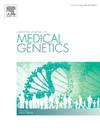Comparison of bilateral tibial lengthening with circular external fixator and simultaneous deformity correction with hexapod external fixator in Achondroplasia
IF 1.7
4区 医学
Q3 GENETICS & HEREDITY
引用次数: 0
Abstract
Achondroplasia is a growth plate dysplasia caused by FGFR-3 gene mutation. In addition to dysmorphic short stature, genu varum is very common. Therefore, a certain part of the achondroplasic population is interested in extensive cosmetic limb lengthening and deformity correction to achieve a functional height so that they can attain total autonomy in everyday life. All patients who underwent bone lengthening treatment from March 2014 to December 2022, were retrospectively analyzed in terms of inclusion and exclusion criteria. To determine any angular deformity in the coronal plane, the Mechanical Axis Deviation was calculated. Patients were divided into two groups: group A included patients who had no angular deformity and therefore performed exclusively cosmetic bilateral tibial lengthening, group B included patients undergoing cosmetic lengthening and simultaneous bilateral multiplanar correction of tibial deformities with hexapod external fixator. The achieved distraction, the external fixator index and the consolidation index were calculated and compared for the two groups. Any adverse event was recorded. According to inclusion and exclusion criteria, 14 patients (28 tibias) diagnosed with Achondroplasia were included (20 tibias group A and 8 tibias group B). We found a statistically significant difference between the two groups regarding the mean age at the time of surgery (p 0.01). The mean MAD value within group B showed a substantial improvement from 56.50 ± 19.1 mm to 14.6 ± 5 mm. Comparing the two groups, we observed a statistically significant difference between both preoperative (p 0.0001) and postoperative (p 0.006) MAD values. The difference found between the two groups was significant also in terms of mean external fixator index (35.9 days/cm versus 52.5 days/cm) and consolidation index (24.2 days/cm versus 37.9 days/cm). Comparing the adverse events found in the two groups no significant differences emerged (p 0.7). In the context of cosmetic lower limb lengthening program for achondroplasic patients, most studies have focused on linear lengthening often underestimating the importance of any associated deformities correction. In our experience, the genu varum correction with the hexapod system showed relevant results in term of MAD improvement. Our results show a significant difference between the two groups in consolidation (p 0.002) and thus also in external fixation (p 0.001) time to the disadvantage of the hexapod group probably due to: higher age (p 0.01) with lower healing potential, greater difficulty in weightbearing and in dynamizing the fixator.
圆形外固定架延长双侧胫骨与六足外固定架同时矫正软骨发育不全的比较
软骨发育不全是由FGFR-3基因突变引起的生长板发育不良。除了畸形矮小外,膝内翻也很常见。因此,一部分软骨发育不全人群对广泛的美容肢体延长和畸形矫正感兴趣,以达到功能高度,使他们能够在日常生活中获得完全的自主性。回顾性分析2014年3月至2022年12月所有接受骨延长治疗的患者的纳入和排除标准。为了确定冠状面的任何角度畸形,计算机械轴偏差。将患者分为两组:A组为无角度畸形,仅行双侧胫骨美容延长术的患者;B组为同时行美容延长术及双侧多平面胫骨畸形六足外固定架矫正术的患者。计算两组实现牵张、外固定架指数和巩固指数并进行比较。记录任何不良事件。根据纳入和排除标准,纳入14例软骨发育不全患者(28例胫骨)(A组20例,B组8例)。两组患者手术时的平均年龄差异有统计学意义(p < 0.01)。B组平均MAD值由56.50±19.1 mm显著改善至14.6±5 mm。比较两组,我们观察到术前(p 0.0001)和术后(p 0.006) MAD值的差异有统计学意义。在平均外固定架指数(35.9天/厘米比52.5天/厘米)和巩固指数(24.2天/厘米比37.9天/厘米)方面,两组之间的差异也很显著。两组不良事件比较无显著性差异(p < 0.7)。在软骨发育不全患者的美容下肢延长计划的背景下,大多数研究都集中在线性延长,往往低估了任何相关畸形矫正的重要性。根据我们的经验,使用六足系统进行膝内翻矫正在MAD改善方面显示出相关结果。我们的研究结果显示,两组之间的巩固(p 0.002)和外固定时间(p 0.001)有显著差异,六足组的劣势可能是由于:年龄较大(p 0.01),愈合潜力较低,负重和固定架动力较困难。
本文章由计算机程序翻译,如有差异,请以英文原文为准。
求助全文
约1分钟内获得全文
求助全文
来源期刊
CiteScore
4.10
自引率
0.00%
发文量
193
审稿时长
66 days
期刊介绍:
The European Journal of Medical Genetics (EJMG) is a peer-reviewed journal that publishes articles in English on various aspects of human and medical genetics and of the genetics of experimental models.
Original clinical and experimental research articles, short clinical reports, review articles and letters to the editor are welcome on topics such as :
• Dysmorphology and syndrome delineation
• Molecular genetics and molecular cytogenetics of inherited disorders
• Clinical applications of genomics and nextgen sequencing technologies
• Syndromal cancer genetics
• Behavioral genetics
• Community genetics
• Fetal pathology and prenatal diagnosis
• Genetic counseling.

 求助内容:
求助内容: 应助结果提醒方式:
应助结果提醒方式:


